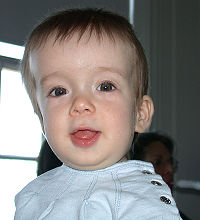
Photo from wikipedia
BACKGROUND Although published data support the utilization of circumferential fusion to treat select cervical spine pathologies, it is unclear whether the posterior-anterior-posterior (PAP) fusion has increased risks compared with the… Click to show full abstract
BACKGROUND Although published data support the utilization of circumferential fusion to treat select cervical spine pathologies, it is unclear whether the posterior-anterior-posterior (PAP) fusion has increased risks compared with the anterior-posterior fusion. OBJECTIVE To evaluate the differences in perioperative complications between the 2 circumferential cervical fusion approaches. METHODS One hundred fifty-three consecutive adult patients who underwent single-staged circumferential cervical fusion for degenerative pathologies from 2010 to 2021 were retrospectively reviewed. Patients were stratified into the anterior-posterior (n = 116) and PAP (n = 37) groups. The primary outcomes assessed were major complications, reoperation, and readmission. RESULTS Although the PAP group was older (P = .024), predominantly female (P = .024), with higher baseline neck disability index (P = .026), cervical sagittal vertical axis (P = .001), and previous cervical operation rate (P < .00001), the major complication, reoperation, and readmission rates were not significantly different from the 360° group. Although the PAP group had higher urinary tract infection (P = .043) and transfusion (P = .007) rates, higher estimated blood loss (P = .034), and longer operative times (P < .00001), these differences were insignificant after the multivariable analysis. Overall, operative time was associated with older age (odds ratio [OR] 17.72, P = .042), atrial fibrillation (OR 158.30, P = .045), previous cervical operation (OR 5.05, P = .051), and lower baseline C1-7 lordosis (OR 0.93, P = .007). Higher estimated blood loss was associated with older age (OR 1.13, P = .005), male gender (OR 323.31, P = .047), and higher baseline cervical sagittal vertical axis (OR 9.65, P = .022). CONCLUSION Despite some differences in preoperative and intraoperative variables, this study suggests both circumferential approaches have comparable reoperation, readmission, and complication profiles, all of which are high.
Journal Title: Neurosurgery
Year Published: 2023
Link to full text (if available)
Share on Social Media: Sign Up to like & get
recommendations!